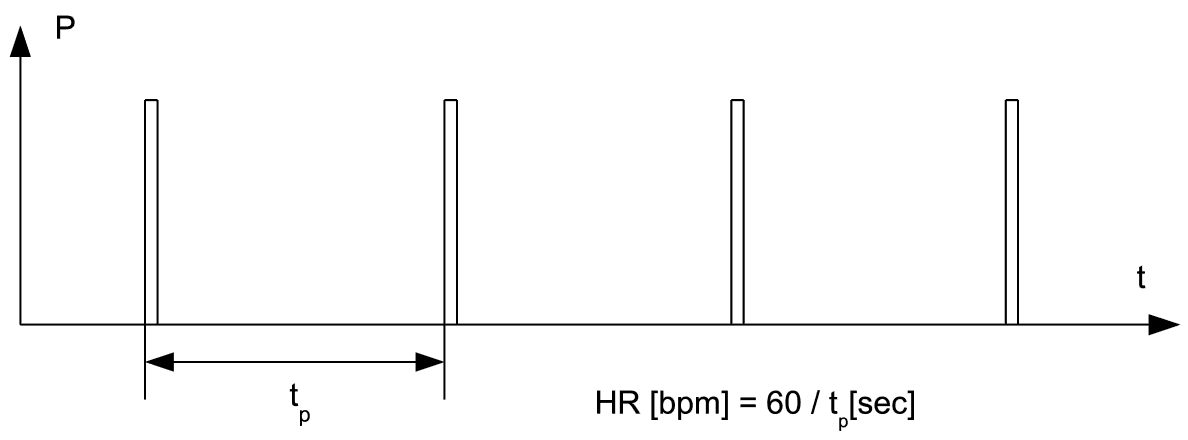Modern heart rate monitors for general public are usually embedded into sports watches and come in two general sorts - one that requires the user to touch a small sensitive pad on the wrist watch, the other one with a chest strap that contains a miniature wireless transmitter.
The first sort of H-R monitors usually has a dedicated touch pad on the front surface of the watch housing, and the watch starts to measure and display user’s heart rate automatically and as long as the pad is touched by a finger of the opposite hand than the one the watch is strapped on. These devices are convenient for runners and other sports folks whose activities either don’t require that their both hands are engaged all the time, so that one hand can be put onto the watch periodically. But there are sports that don’t permit so. Cycling is an example of such a sport: lifting one hand from the handlebar is not so dangerous and is in fact performed quite often, but then putting it onto the opposite wrist... you really don’t want to do it while climbing a hill or worse - speeding down it.
Wireless heart rate monitors
In order to enable cyclists to measure the heart rate safely and conveniently, manufacturers developed two part devices. Heart rate sensory circuit together with it’s own coin battery and a tiny radio transmitter is housed inside a so called chest strap which is fixed onto the user’s chest during activity. Each heart beat produces a short pulsed radio signal which is then picked up by a tuned receiver inside the watch, which continually processes and displays the result. It seems that practically all manufacturers miraculously agreed upon the 5kHz carrier frequency - a consensus like this is a remarkably rare instance in the long history of technology. This of course makes our task easier. Carrier frequency of merely 5kHz may seem absurdly too low for a “radio” device, but having in mind the data rate (a few bps) and typical distances over which these devices transfer that data (length of a human hand), it in fact suffices nicely.
Although exactly the same physical laws are in power for radio circuits operating in GHz- as well as those operating in kHz (or Hz or even mHz etc.) range, engineers coined a special term “near field communications” for very low frequency devices. The idea is that at such low frequencies, wavelengths of generated radio waves are so long (tens of kilometers) that almost any transmitter/receiver pair one can build communicates being mutually much closer than even a single wavelength. Arm length surely fits this category. Under such conditions, and having in mind the fact that any practical antenna is a lot shorter than the wavelength of radiated waves, applying antenna radiating patterns and the rest of the well studied radio theory to the system is questionable. It in fact turns out that thinking of the radiating coil not as of a transmitter antenna but instead as of a primary winding of a transformer, and similarly thinking of the receiving coil as of the secondary of such “distributed” transformer, gives better estimates for currents and voltage generated in the receiver dictating the achievable communications range. To put it simply, the transmitter lets a certain amount of alternating current to flow through the transmitting coil which generates alternating magnetic field around it. If the receiving coil is close enough, alterations in magnetic field induce alternating currents and voltage in it, which we then pick up by a sensitive amplifier and process further. Both transmitter and receiver coils can of course be made resonant by connecting capacitors of adequate size in parallel to them.

Magnetic pulses given off by heart rate monitors are very low power for two main reasons. Firstly, every generated pulse drains the small 3V battery inside the chest strap a bit so the stronger the pulses, the shorter the battery life span. Secondly, cyclists and other sport people often enjoy their activities in groups, so if several of them wore wireless heart rate devices, the mutual interference would lead to funny results being displayed on their watches. The latter problem is dealt with in more sophisticated devices by digitally encoding the pulses, but the majority of reasonably priced models still produces just simple singular pulses. It is useful to note that both types of signals (uncoded as well as coded) can be picked up by simple receivers designed for receiving uncoded pulses, which makes building experimental home brew receivers a lot easier.

